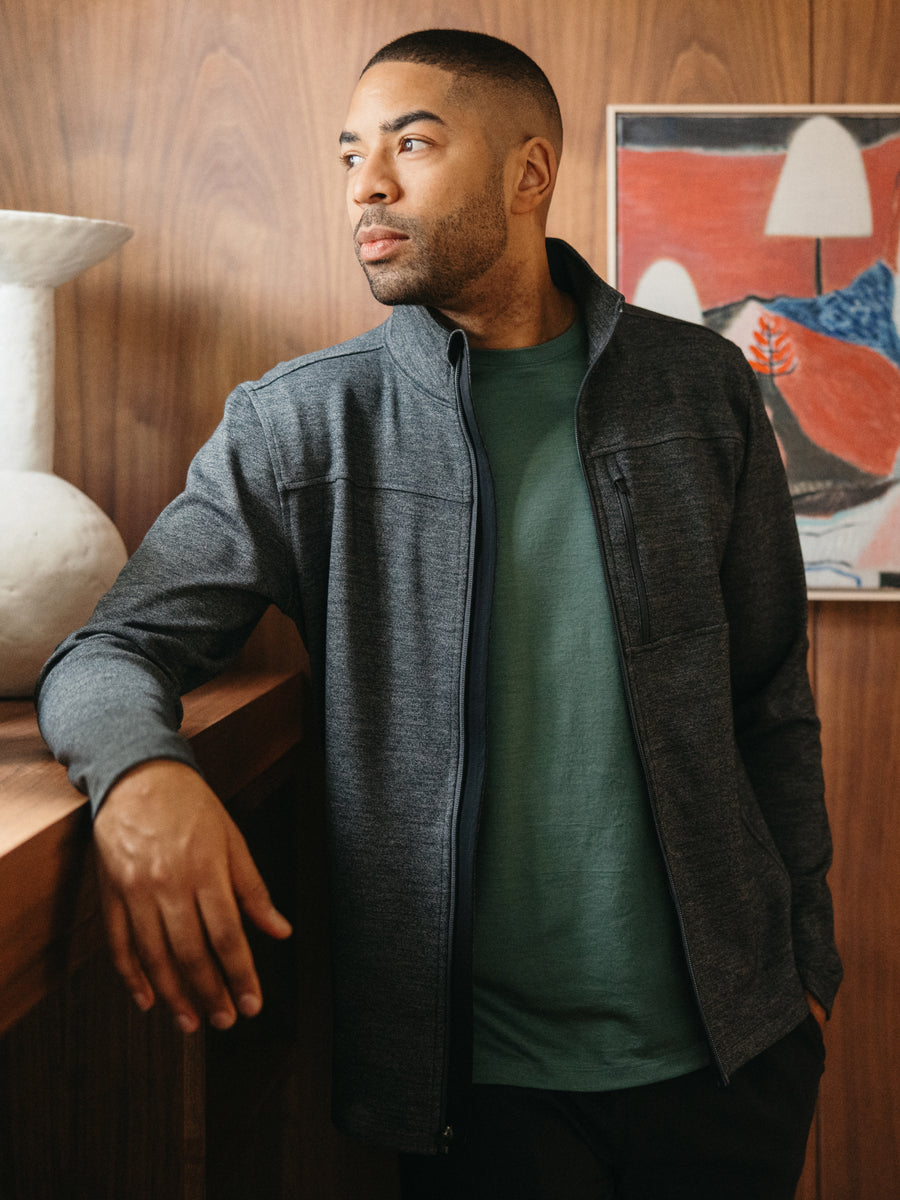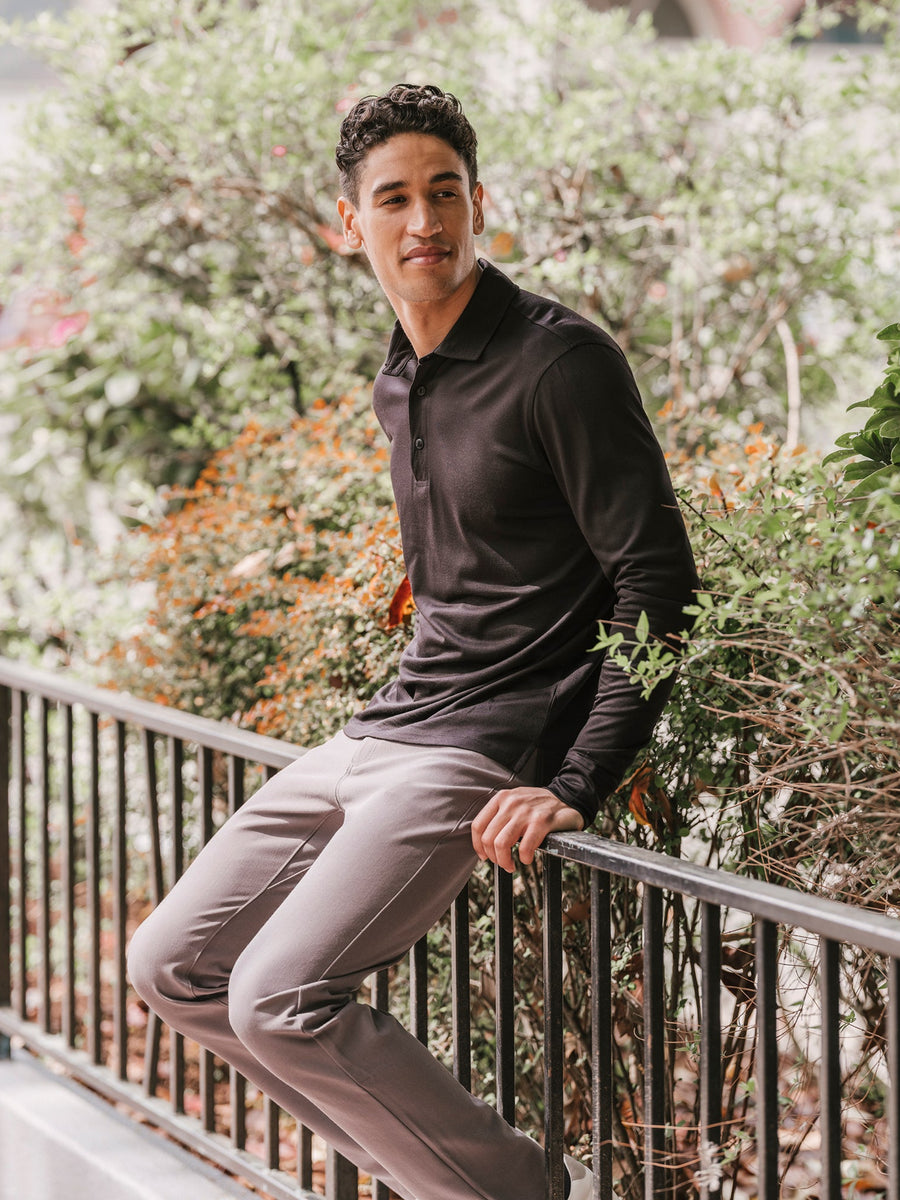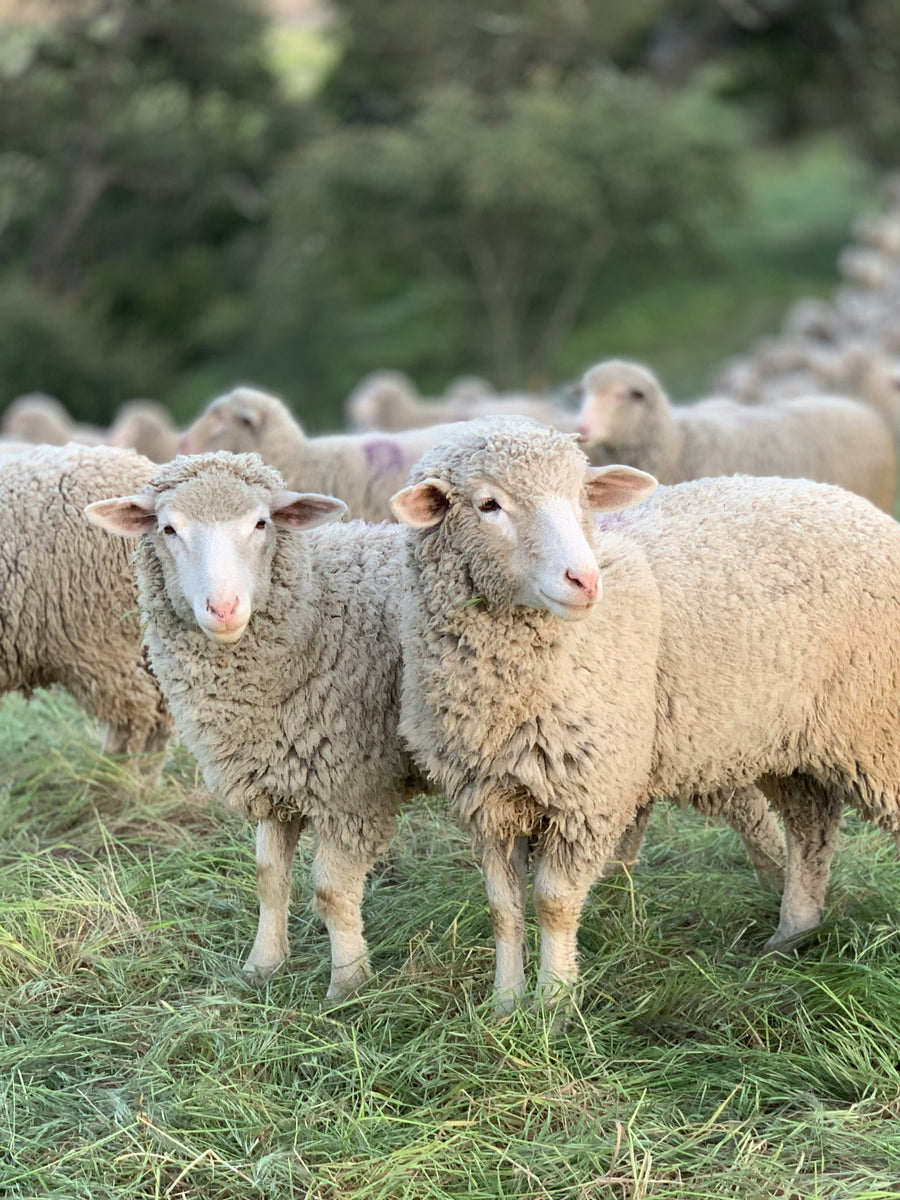Why Merino Wool?
|
Wearable year-around
Merino wool is both hygroscopic and thermostatic. This means that it regulates both humidity and temperature to keep you cool in the summer and warm in the winter.
Merino Wool absorbs and desorbs water vapor (hygroscopic) to keep the wearer comfortable. It can absorb 20% of its own weight before feeling damp and doesn’t feel wet until it’s saturated with 60% of its own weight in moisture. This means that in cool, wet weather, Merino Wool can get damp without feeling wet keeping the wearer feeling dry. In high humidity, Merino Wool keeps its distance from the skin which allows for air circulation keeping the wearer feeling cool and dry.
Merino Wool fibers are nonconductors of heat (thermostatic) permitting the wearer to retain its normal temperature. In cool weather, Merino Wool fibers trap pockets of air that act as insulation, keeping the wearer warm. In transitional weather, Merino Wool maintains the wearer’s temperature from cool mornings to warm afternoons. In warm weather, light weight Merino Wool is breathable and wicks moisture away from the skin allowing it to evaporate, keeping the wearer cool.
It’s easy and comfortable
Merino wool is composed of a natural protein known as keratin, the same protein as human hair. Merino Wool fibers can have up to 3000 microscopic scales per inch and is naturally wavy. These attributes give Merino Wool clothing properties that make it easy to wear and easy to take care of it.
Merino wool is naturally wrinkle resistant due to the resilience of the wool fibers. The wool fibers remember their natural state and work against any forces trying to change its natural state, such as crumpling and crushing. This means in a garment form, Merino Wool fabric wrinkles less and any wrinkles easily disappear with a little steam.
Merino Wool is naturally antibacterial and wicks sweat away from the surface of the skin, reducing body odor. When sweat remains on the body, bacteria develop and causes body odor. Merino wool absorbs sweat and brings it to the surface of the fabric allowing it to evaporate into the air, reducing the opportunity of odors.
Merino wool is neutrally charged so it does not attract or retain stains and soils. Initially, Merino wool tends to be water-repellent so droplets of water or beer stay on the surface of wool fabrics making it easy to be brushed off before they are absorbed. Dirt is easy to brush off.
Merino Wool has a high Tensile Strength. Compared to other fibers, Merino Wool can withstand more pressure before the material is ruptured or ripped making it more durable. Unfortunately, Merino Wool has a low Tensile Strength when wet, so Merino Wool garments should never be pulled or wrung while wet.
Merino Wool has high Dimensional Stability. Compared to other fibers, Merino Wool has the ability to retain its shape and size after wear and washing.
Due to the crimp, the natural waviness in the Merino Wool fiber, they can stretch between 25% and 30% of their natural length before breaking. This enables the fabric to move with the wearer’s body for a more comfortable feel. To preserve the natural elasticity, woven Merino Wool garments should be hung properly after wearing; knit Merino Wool garments should be folded and allowed to relax sufficiently to regain their shape between wearing.
Merino Wool garments also provide natural protection from UV light and UVB rays.
Due to Wool’s inherent chemical structure, Merino Wool is naturally flame resistant. It’s harder to ignite and never melts. In the unlikely event that wool does ignite, it normally won’t sustain a flame because its natural chemical structure requires more oxygen than the atmosphere normally contains. It either burns very slowly or goes out.
Superfine Merino Wool fiber (15 to 18.5 micron) is soft against the skin and has even been shown to reduce eczema symptoms. Coarse wool (greater than 30 micron) has been known to prickle and itch when the fiber ends press against the skin and trigger nerve endings know as nociceptors. This is an irritation and not an allergy. The perception of a prickly sensation corresponds directly with the fineness of a fabric – the finer the fabric, the less irritation.
Less is more
Merino Wool garments have many properties that make them versatile workhorses in your wardrobe with the average service life of many Merino Wool garments being several years, even decades. From the Founder’s 100-day challenge to minimizing our footprint on earth, Merino Wool makes sense.
Nature provides everything required to make Merino Wool: sunshine, fresh air, grass and water. It’s naturally renewable, recyclable and biodegradable. If composted, Merino Wool decomposes, slowly releasing nitrogen based nutrients into the soil.
Merino Wool easily absorbs dyes allowing for rich colors with minimal process and chemicals. Colors stay true with no noticeable change in shade during the normal life of the garment and do not crock or rub-off on other items.
Merino Wool garments are versatile and can be layered and worn for multitude of occasions. The garments move from casual to travel to office wear with ease. Layering allows the wearer to be comfortable in most climates.
Most Merino Wool garments are home washable reducing Dry Cleaning solvents.
|
What is Merino Wool?
|
History of Merino Wool
Even though the story of wool begins during the Stone Age, the Merino Wool story starts in the Middle Ages when Spain developed a breed of Merino wool sheep with outstanding quality fiber. Spain’s thriving wool trade helped finance the voyages of Columbus and the Conquistadors. These Merino sheep were so prized that it was a capital offense to export a Merino sheep from Spain until 1786.
Columbus brought sheep to Cuba and Santo Domingo on his second voyage in 1493, and Cortez took their descendants along when he explored what is now Mexico and the southwestern United States.
At the turn of the 18th century small flocks in the hands of pioneers started the Merino Wool industry in Australia, New Zealand and South Africa. By 1870, Australia produced finer and finer wool fiber and was the number one wool producer and supplier.
Today, 17.5 micron superfine Merino Wool accounts for less than 9% of the total Australian wool production while 18.5 micron accounts for less than 15% of the total Australian wool production.
Types of sheep
There are about forty breeds of sheep with over 200 distinct grades of sheep, counting the crossbreeds. To simplify the grading process, Wool producing sheep are classified into four groups according to the quality of the wool produced.
Merino Wool is the highest quality and finest wool making it the best wool obtained anywhere in the world, Class-one wool. The fiber is strong, fine and elastic and has good working properties. It has the greatest amount of crimp of all wool fibers and has a maximum number of scales. These factors contribute to its superior warmth and spinning qualities.
Delaine-Merino and Rambouillet are the best-known sheep varieties that produce high-quality, fine-wool Merino. Their ewes weigh between 125 – 180 lbs with rams weighing as much as 300 lbs.
Class-two wool is a very good quality and helped make the British Isles famous for their fine wool fabrics. The fiber has a large number of scales per inch and has good crimp. Some of the better known sheep of this variety include Berkshire, Cornwall, Hampshire and Welsh Mountain.
Class-three wool can be used for clothing, but is coarser with less crimp.
Class-four wool is often heavy and bulky and is mainly used for carpets and home furnishings.
Types of wool
Merino Wool is the highest quality and finest wool making it the best wool obtained anywhere in the world.
Lamb’s wool is the first or virgin clipping from the animal; fine quality; the fibers are tapered because the ends have never been clipped
Virgin Wool is new wool that has never been used before, or reclaimed from any spun, woven, or knitted products
Cashmere, as a comparison, is the fine, downy undercoat hair of the cashmere goat. The hair is soft, strong and silken-like with a diameter of less than 16 microns.
|
How is Merino Wool processed?
|
From fleece to fiber
Wool grows from the skin of the sheep. The quality of the wool fiber is determined by the breeding, climate, food, care and health of the sheep with superior wool coming from the sides and shoulders where it grows longer, finer and softer.
Usually in the springtime, fleeces are manually removed in one piece by machine clippers, similar to enlarged barber’s shear. A skilled worker, using long, smooth strokes close to the skin, can shear about 150 sheep a day. Each fleece weighs about ten pounds.
Graders, experts in distinguishing qualities by touch and sight, determined the type, length, fineness, crimp, elasticity and strength of the fleece. The diameter of wool fibers is measured in microns, the length of the fiber is measured in inches. The longer and finer the fiber, the higher the quality and price.
Newly sheared wool contains the natural oil of the sheep, so it needs to be cleaned or scoured to remove the grease (unrefined lanolin), vegetable matter and other impurities. Through raking the wool through a series of tubs of soap and water, the fleece loses from 20 to 80 percent of its original weight.
From fiber to yarn
Combing/Carding prepares the wool for spinning. Through a system of rollers, combing/carding removes additional vegetable matter, separates the fibers, lays them parallel to each other, forms the wool into a thin web and then condenses them into a single continuous untwisted strand of bundle of fibers call a “sliver”. The Sliver is then put through a drawing process where the sliver is drafted, doubled and redoubled to make it more uniform before spinning into worsted yarns, a "roving".
Spinning turns the roving, fairly loose fibers, into yarn, a sturdy continuous strand that can be used for weaving or knitting. Through a woolen spinning system, that creates relatively loosely twisted, soft, fluffy yarns, or a worsted spinning system, that creates tighter twisted, smoother, thinner yarns, a wide variety yarns are created specifically for a variety of products. Yarns used in light-weight knits tend to be worsted spun, with less twist. Yarns used in light-weight wovens tend to be worsted spun with high twist to withstand power looms. Spinning requires a great amount of art and engineering to bring all the factors together to create the perfect yarn that appropriate for the diameter and length of the fiber and the end-use.
Plying or wrapping yarns together, increases the variety of looks and end-uses of the yarn. It also enables the mixing of different fibers to maximize performance. Our supplier uses their patented LincSpun technology to wrap 17.5 micron Merino Wool with a super-soft, micro nylon filament yarn to increase the durability and strength, plus to reduce the pilling of our knitted Merino Wool jersey. This patented process significantly increases the tensile and burst strength, increases the abrasion resistance, reduces pilling and minimizes the fabric twist.
From yarn to fabric
Weaving and knitting are the most popular ways of turning yarn into fabric. The method and the science behind turning yarn into fabric determines the hand - the reaction of the sense of touch - and the character of a material: weight, drapability, elasticity, fineness, durability, softness etc.
Weaving produces cloth by interlacing two sets of yarn at right angles. The weight and drape of a fabric is a function of the yarn size and the number of yarns per inch, the fabric count. The vertical yarns, known as the warp are drawn through the weaving loom where the horizontal yarns, the weft or fill, are carried across the loom. Depending on how the loom is prepared, the raising and lowering of the warp results in different patterns. Two popular weaves are plain weave, which is a smooth fabric, and a twill weave, which has diagonal ridges.
There are two major knitting processes, flat bed which produces shaped pieces that are sewn together into sweaters or circular knitting which produces fabrics that is cut into shapes and then sewn together into knit tops. Jersey knit is constructed by interloping yarn by the use of needles, has a flat/smooth face and stretches in two directions.
Solid color fabrics are usually woven or knit in a natural state, greige, then dyed and finished for a uniform color.
Due to the nylon content in our knitted fabrics, they can be cross-dyed, the ability to dye the wool a different color than the nylon, that creates different hues and unique color combinations from the natural, greige state fabric.
If fibers are dyed and then colors combined during carding, this is called stock-dyed, or heather colors and creates a mottled or mélange type of yarn.
End-on-end fabrics are created by alternating colors of yarn as they are fed into the knitting machine or weaving loom.
Plaids are created by dyeing cones of yarn and then organizing the yarn in color bars or stripes on the weaving loom to create the warp, or vertical yarn in the fabric. Then, dyed yarn is interlaced at right angles with the warp yarn in an organized progression to create the plaid pattern.
|



